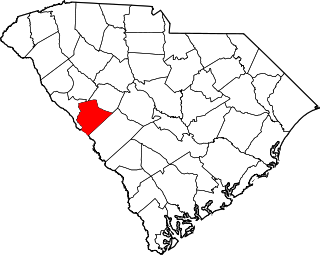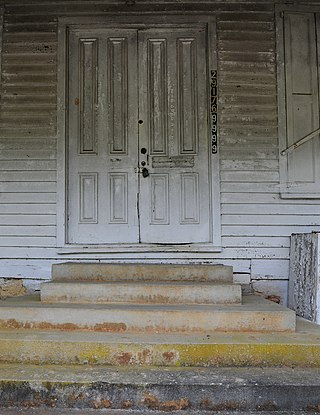
Edgefield is a town in and the county seat of Edgefield County, South Carolina, United States. The population was 4,750 at the 2010 census.

Trenton is a town in Edgefield County, South Carolina, United States. The population was 196 at the 2010 census, down from 226 in 2000.

Seneca is a city in Oconee County, South Carolina, United States. The population was 8,102 at the 2010 census. It is the principal city of the Seneca Micropolitan Statistical Area, an (MSA) that includes all of Oconee County, and that is included within the greater Greenville-Spartanburg-Anderson, South Carolina Combined Statistical Area. Seneca was named for the nearby Cherokee town of Isunigu, which English colonists knew as "Seneca Town".

Table Rock State Park is a 3,083-acre (12.48 km2) park at the edge of the Blue Ridge Mountains in northern Pickens County, South Carolina. The park includes Pinnacle Mountain, the tallest mountain totally within the state.

The Seneca Institute – Seneca Junior College was an African-American school in Seneca, South Carolina, from 1899 to 1939. This was in a period of segregated public schools in South Carolina.
This is an incomplete list of historic properties and districts at United States colleges and universities that are listed on the National Register of Historic Places (NRHP). This includes National Historic Landmarks (NHLs) and other National Register of Historic Places listings. It includes listings at current and former educational institutions.
William Augustus Edwards, also known as William A. Edwards was an Atlanta-based American architect renowned for the educational buildings, courthouses and other public and private buildings that he designed in Florida, Georgia and his native South Carolina. More than 25 of his works have been listed on the National Register of Historic Places.
Zechariah Lawrence Bettis was an American politician who served as the Probate Judge of Clarke County, Alabama during the American Civil War. He was born in Edgefield, South Carolina and was a part of a migration from Edgefield County to Clarke County. In 1856, he was elected the Probate Judge of Clarke County. Under the constitution of the time, the Probate Judge was the chief executive official of an Alabama county. He remained in this office until 1866. He died in Grove Hill, Alabama in 1879.

This is a list of the National Register of Historic Places listings in Edgefield County, South Carolina.

Horn Creek Baptist Church is a historic Baptist church in Edgefield, South Carolina. The congregation was founded in 1768 and the current building was constructed in 1790 and remains one of the oldest buildings in the county. The church was added to the National Register of Historic Places in 1971.

The Jesse Pickens Pugh Farmstead is a historic 289-acre (117 ha) homestead near Grove Hill in rural Clarke County, Alabama, United States. The homestead contains seven contributing buildings, two contributing sites, and one contributing structure. These include a half-spraddle roof cottage that was built in 1865, agricultural outbuildings, agricultural fields, and burials. The complex was listed on the National Register of Historic Places on July 28, 1999, due to its architectural significance.

Darby Plantation plantation house was built by Nathaniel Lipscomb Griffith, the father of Anne Patience Griffith, at the time of her marriage to Edgefield lawyer Milledge Luke Bonham. It has a deep wraparound porch supported by twelve columns. The main rooms are twenty feet by twenty feet with twelve foot ceilings, and the house is built of pine. When Bonham returned from the United States' war with Mexico, he was elected to the U.S. House of Representatives. At the outbreak of the Civil War, Bonham was put in charge of South Carolina's volunteer army and served with distinction. In 1862, he resigned his commission and became governor of South Carolina. In 1863, the house was sold to Confederate Secretary of the Treasury George Trenholm. During the Civil War, the house was used as a storage place for some of the items from the Charleston Museum. Since 1878, the plantation has been owned by the Wise family.

Marshfield, also known as Old Marsh Home Place, is a historic plantation house located near Trenton, Edgefield County, South Carolina. The original house, built about 1831, rests on a foundation of brick and granite rocks. The house is an L-shaped, one-story frame residence with additions and alterations made in the late-19th and early-20th centuries. Also located on the property are the contributing early-19th century shed or "smokehouse"; an early 19th-century house, constructed of hand-hewn and pegged timbers and containing a stone fireplace; the Marsh family cemetery; and the archaeological remains of additional outbuildings.

Johnston Historic District is a national historic district in Johnston, Edgefield County, South Carolina. The district encompasses 127 contributing buildings, 16 contributing sites, 1 contributing structure, and 1 contributing object in the village of Johnston. The district includes commercial and residential properties from approximately 1880 to 1920. They are in a variety of popular architectural styles such as Italianate, Second Empire, Victorian, Queen Anne, and Neo-Classical. The district also includes three churches and the town's cemetery. The railroad, which passes through Johnston, was the primary cause for the creation of the town and continues to be a reminder of the town's early transportation history. Notable buildings include the Johnston Depot, Western Carolina Bank, H. W. Crouch Building, Bank of Johnston, Crouch-Halford House, and Johnston First Baptist Church.

Edgefield Historic District is a national historic district located at Edgefield, Edgefield County, South Carolina. The district encompasses 33 contributing buildings, 6 contributing sites, and 1 contributing object in the town of Edgefield. The buildings center on the landscaped village green, and includes forty 19th century buildings, three of which are house museums. There are a number of 19th century Greek Revival style homes, while others are noted for beautiful Federal style fanlights and unusual doorways. Other district properties include Victorian influenced homes and downtown commercial buildings. Five churches represent the Georgian, Victorian Gothic, and modified Gothic architectural styles. Notable buildings include the Edgefield County Courthouse, Trinity Episcopal Church and Rectory, St. Mary's Catholic Church, Halcyon Grove, Oakley Park, Carroll Hill, Blocker House, Yarborough House, and Padgett House.

White Oak Historic District is a national historic district located near Winnsboro, Fairfield County, South Carolina. The district encompasses 12 contributing buildings in the rural community of White Oak. The buildings in the district were built between about 1876 and about 1925, and includes three large frame residences, a frame church with steeple, two frame store buildings, a cotton warehouse, and two vacant, wooded lots, some of which reflect Victorian stylistic influences. Notable buildings include the T. G. Patrick Store, McDowell's Store, White Oak Cotton Warehouse, Matthew Patrick House, T. G. Patrick House and outbuildings, and White Oak A.R.P. Church and Manse.
Keithfield Plantation is a historic rice plantation property and national historic district located near Georgetown, Georgetown County, South Carolina. The district encompasses 1 contributing building, 1 contributing site, and 3 contributing structures. They include a slave cabin, built about 1830, and agricultural features including examples of historic ricefields, canals, dikes, and trunks. The original main house burned in the mid-20th century. Keithfield was one of several productive rice plantations on the Black River.

Faith Cabin Libraries were a system of libraries created in South Carolina and Georgia providing library services to Black Americans who were not allowed to use public libraries because of segregation laws.

The Faith Cabin Library at Seneca Junior College is a Faith Cabin Library built to serve the African American community in Seneca, South Carolina. It was built on the campus of the Seneca Junior College. The log cabin library building was named to the National Register of Historic Places on November 14, 2012.



















